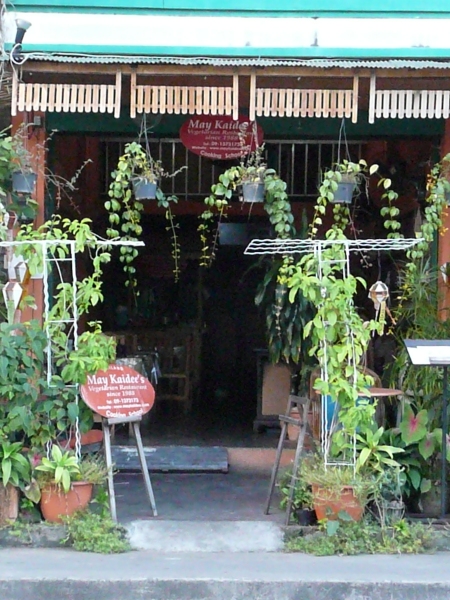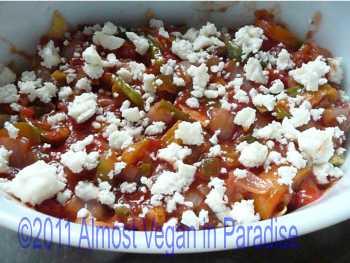The first thing I did upon arrival in Chiang Mai, Thailand, was head to May Kaidee’s Vegetarian Restaurant. It’s on Ratchapakinai Road, next to the Sumit Hotel, about 4 doors up from the Thai Red Cross office, which is easy to spot.

Look for the plants in front of the tiny shop.
I had a bowl full of something luscious, with coconut milk curry and vegetables, and I was immediately happy.
Last time I was in Chiang Mai, I took a cooking class from The Farm, an organic farm about 20 minutes out of the city. It was a well-organized class, the food was delicious, and it was a nice break to get out of the city and spend a relaxing day making mouth-watering food. I highly recommend it.
This time I wanted to take a class that was specifically vegetarian, not just a cooking class that substituted vegetarian ingredients. Since May Kaidee’s had a cooking class available, I had to taste the food before signing up.
No use taking a cooking class from somewhere with tasteless, or worse, awful food.
So I was relieved that the food was delicious and that it was close enough to my guesthouse, which meant I would be coming back often to eat. (I did–I went every day except when I was out of commission due to food poisoning…grr.)
Class started at 9 am with a bowl of fruit and yogurt for breakfast. Then the other three students and I, plus Duan, May’s sister, who runs the Chiang Mai restaurant with her husband, daughter, and brother, set off for the local market.
There Duan pointed out and explained several ingredients crucial to Thai cuisine. She showed us sticky rice, kaffir limes, ginger, galangal, lemongrass, holy and Thai basils.

Choy sum swarming with bees
Most of the produce was already familiar to me, including long beans, choy sum (Chinese greens with yellow flowers that the bees were swarming around), gailaan (sometimes called Chinese broccoli, and what Duan called kale), round and long eggplant, pumpkin (large, flat, and brown, like a more rowdy cousin of the Japanese
kabocha).
The Thai papayas are enormous, at least eight inches long, orange and shaped like a cylinder. The papayas in Hawaii are much smaller, shaped like yellow pears on steroids.
We also saw the rice noodles that people ordered by width and watched the vendor chop them with her cleaver before putting them into a tiny plastic bag secured with a rubber band. The thin version, like fetuccini, are what is used to make Pad Thai, the popular fried noodle dish. The uncut sheets are the wrappers for uncooked spring rolls.
After filling our baskets, we walked back to the shop, past a rotund yellow dog that took up half the road. Cars, people and motorcycles inched around it to pass. We couldn’t decide if she was pregnant or just obese.

The Somphet Market Dog--fat or pregnant?
Back at the shop, we chopped some baby corn, greens, and cauliflower before heading upstairs with bottles of drinking water, to get to work.
Each of us had a station with a wok and shared areas with dark and light soy sauce, chili paste and already-chopped garlic and chilies.
For each recipe, Duan walked us through the steps. “Put one spoonful of oil in your wok. Now add chilies, half spoon, and garlic, half spoon.” Spoons were the Asian soup spoons, the long ones with handles bent upwards, that come with bowls of gau gee min and ramen, Asian noodle soups.
“Now, quickly…KHON!”
That meant “Stir!” in Thai. We spent many hours that day khon-ing.
“Next put tofu and vegetables….khon faster!”
And so it went. After the first three dishes, I lost track of how much of what went into what. Fortunately, all the recipes had been printed out for us, so we stopped after a few to make notes about substitutions and anything else not already written for us.

Duan prepares rice wrappers to make uncooked spring rolls.
Each of us had a tasting spoon, which we kept in a pocket in the front of our aprons, for sampling the dishes as we finished. This was an interesting part of the course, because we learned how much of a difference in flavor small substitutions could make.
For example, clear Tom Yum, coconut Tom Yum, and Tom Kha soups were identical, save for the amounts of coconut milk we added, but the flavors were more different than you’d imagine.
Four hours later, we had a spread large enough to feed us all for lunch and dinner. Fried noodles, soups, several kinds of curries, and the famous Kao Soi, a northern Thai curried noodle specialty.

The finished uncooked spring rolls: light, fresh, chewy, crunchy, spicy, and refreshing, all at once.
We also made lip-smacking peanut sauce, and May Kaidee’s famous and possibly the most popular dish on the menu: Pumpkin Hummus. Various seeds, spices, chilies, and cooked pumpkin were pounded with a mortar and pestle. The end result was creamy, complex pumpkin magic.
Duan said it was their mother’s special recipe. She used to make it for them growing up, and they ate it with everything, from balls of sticky rice, to spread on bread as sandwiches, or as a dip with vegetables. It was easy to see why this was such a popular dish.
The only non-vegan things were the yogurt in the morning, plus the egg noodles in the Kao Soi. But that was a variation on a curry dish, so you could leave them out.
I gave my leftovers to my Thai massage friends, since I did not have a fridge in the guesthouse and did not want to tempt fate with even more food poisoning.
Thank you, Duan, An, Nain, and Opal, for delicious food every day, and for your help! Khob kun mahk kha!
If you are interested in taking the cooking class, visit the restaurant and talk to one of them. I highly recommend it.

May Kaidee Vegetarian Restaurant, Chiang Mai, Thailand







 Posted by almostveganinparadise
Posted by almostveganinparadise 












